Whole Exome Sequencing-Based Identification of a Novel Gene Involved in Root Hair Development in Barley (Hordeum vulgare L.)
Abstract
1. Introduction
2. Results
2.1. Isolation and Phenotyping of the rhp1.e Mutant
2.2. Exome Sequencing Output Data
2.3. Characterization of the HORVU1Hr1G077230 Gene and an Encoded Protein
2.4. Analysis of the Identified Mutation in HvCSLC1
2.5. Identification of the Mutations in Allelic Mutants and Their Impact on the Protein Function
2.6. Expression Level of the HvCSLC1 and Other Genes Potentially Involved in the XyG Biosynthesis in Root Hairs
3. Discussion
4. Materials and Methods
4.1. Plant Material
4.2. Growth Conditions and Root Hair Phenotyping
4.3. Microscopic Analysis
4.3.1. Light Microscopy and the Scanning Electron Microscope (SEM)
4.3.2. Confocal Laser-Scanning Microscopy (CLSM)
4.4. DNA Isolation
4.5. Genetic Analysis
4.6. Exome Capture Experiment Design and Candidate Gene Selection
4.7. Identification of Mutations and Sequence Analysis of Selected Genes
4.8. RNA Isolation and Gene Expression Analysis
5. Conclusions
Supplementary Materials
Author Contributions
Funding
Data Availability Statement
Acknowledgments
Conflicts of Interest
References
- Datta, S.; Kim, C.M.; Pernas, M.; Pires, N.D.; Proust, H.; Tam, T.; Vijayakumar, P.; Dolan, L. Root hairs: Development, growth and evolution at the plant-soil interface. Plant Soil 2011, 346, 1–14. [Google Scholar] [CrossRef]
- Gahoonia, T.S.; Nielsen, N.E.; Priyavadan, A.J.; Jahoor, A. A root hairless barley mutant for elucidating genetic of root hairs and phosphorous uptake. Plant Soil 2001, 235, 211–219. [Google Scholar] [CrossRef]
- Klamer, F.; Vogel, F.; Li, X.; Bremer, H.; Neumann, G.; Neuhäuser, B.; Hochholdinger, F.; Ludewig, U. Estimating the importance of maize root hairs in low phosphorus conditions and under drought. Ann. Bot. 2019, 124, 961–968. [Google Scholar] [CrossRef]
- Mercado-Blanco, J.; Prieto, P. Bacterial endophytes and root hairs. Plant Soil 2012, 361, 301–306. [Google Scholar] [CrossRef]
- Kijne, J.W. The Rhizobium infection process. In Biological Nitrogen Fixation; Stacey, E., Burris, R.H., Evans, H.J., Eds.; Chapman and Hall: New York, NY, USA, 1992; pp. 349–398. [Google Scholar]
- Oldroyd, G.E.; Downie, J.A. Coordinating Nodule Morphogenesis with Rhizobial Infection in Legumes. Annu. Rev. Plant Biol. 2008, 59, 519–546. [Google Scholar] [CrossRef]
- Cormack, R.G.H. The development of root hairs in angiosperms. Bot. Rev. 1949, 75, 583–612. [Google Scholar] [CrossRef]
- Schiefelbein, J.W. Constructing a Plant Cell. The Genetic Control of Root Hair Development. Plant Physiol. 2000, 124, 1525–1531. [Google Scholar] [CrossRef] [PubMed]
- Foreman, J.; Dolan, L. Root Hairs as a Model System for Studying Plant Cell Growth. Ann. Bot. 2001, 88, 1–7. [Google Scholar] [CrossRef]
- Marzec, M.; Melzer, M.; Szarejko, I. Asymmetric growth of root epidermal cells is related to the differentiation of root hair cells in Hordeum vulgare (L.). J. Exp. Bot. 2013, 64, 5145–5155. [Google Scholar] [CrossRef]
- Vissenberg, K.; Claeijs, N.; Balcerowicz, D.; Schoenaers, S. Hormonal regulation of root hair growth and responses to the environment in Arabidopsis. J. Exp. Bot. 2020, 71, 2412–2427. [Google Scholar] [CrossRef] [PubMed]
- Schoenaers, S.; Balcerowicz, D.; Vissenberg, K. Molecular Mechanisms Regulating Root Hair Tip Growth: A Comparison with Pollen Tubes. In Pollen Tip Growth; Obermeyer, G., Feijó, J., Eds.; Springer: Cham, Switzerland, 2017; pp. 167–243. [Google Scholar] [CrossRef]
- Marzec, M.; Melzer, M.; Szarejko, I. Root Hair Development in the Grasses: What We Already Know and What We Still Need to Know. Plant Physiol. 2015, 168, 407–414. [Google Scholar] [CrossRef] [PubMed]
- Ischebeck, T.; Seiler, S.; Heilmann, I. At the poles across kingdoms: Phosphoinositides and polar tip growth. Protoplasma 2010, 240, 13–31. [Google Scholar] [CrossRef] [PubMed]
- Carol, R.J.; Dolan, L. Building a hair: Tip growth in Arabidopsis thaliana root hairs. Phila. Trans. R. Soc. Lond. B 2002, 357, 815–821. [Google Scholar] [CrossRef][Green Version]
- Shibata, M.; Sugimoto, K. A gene regulatory network for root hair development. J. Plant Res. 2019, 132, 301–309. [Google Scholar] [CrossRef] [PubMed]
- Meng, F.; Xiang, D.; Zhu, J.; Li, Y.; Mao, C. Molecular mechanisms of root development in rice. Rice 2019, 12, 1–10. [Google Scholar] [CrossRef]
- ZhiMing, Y.; Bo, K.; XiaoWei, H.; ShaoLei, L.; YouHuang, B.; WoNa, D.; Ming, C.; Hyung-Taeg, C.; Ping, W. Root hair-specific expansins modulate root hair elongation in rice. Plant J. 2011, 66, 725–734. [Google Scholar] [CrossRef]
- Ma, N.; Wang, Y.; Qiu, S.; Kang, Z.; Che, S.; Wang, G.; Huang, J. Overexpression of OsEXPA8, a root-specific gene, improves rice growth and root system architecture by facilitating cell extension. PLoS ONE 2013, 8, 1–10. [Google Scholar] [CrossRef]
- Zou, H.; Wenwen, Y.; Zang, G.; Kang, Z.; Zhang, Z.; Huang, J.; Wang, G. OsEXPB2, a β-expansin gene, is involved in rice root system architecture. Mol. Breed. 2015, 35, 1–14. [Google Scholar] [CrossRef]
- Kim, C.M.; Park, S.H.; Je, B.I.; Park, S.H.; Park, S.J.; Piao, H.L.; Eun, M.Y.; Dolan, L.; Han, C.-D. OsCSLD1, a Cellulose Synthase-Like D1 Gene, Is Required for Root Hair Morphogenesis in Rice. Plant Physiol. 2007, 143, 1220–1230. [Google Scholar] [CrossRef] [PubMed]
- Wang, S.; Xu, Y.; Li, Z.; Zhang, S.; Lim, J.-M.; Lee, K.O.; Li, C.; Qian, Q.; Jiang, D.A.; Qi, Y. OsMOGS is required for N-glycan formation and auxin-mediated root development in rice (Oryza sativa L.). Plant J. 2014, 78, 632–645. [Google Scholar] [CrossRef] [PubMed]
- Wang, C.; Li, S.; Ng, S.; Zhang, B.; Zhou, Y.; Whelan, J.; Wu, P.; Shou, H. Mutation in xyloglucan 6-xylosytransferase results in abnormal root hair development in Oryza sativa. J. Exp. Bot. 2014, 65, 4149–4157. [Google Scholar] [CrossRef] [PubMed]
- Huang, J.; Kim, C.M.; Xuan, Y.-H.; Park, S.J.; Piao, H.L.; Je, B.I.; Liu, J.; Kim, T.H.; Kim, B.-K.; Han, C.-D. OsSNDP1, a Sec14-nodulin domain-containing protein, plays a critical role in root hair elongation in rice. Plant Mol. Biol. 2013, 82, 39–50. [Google Scholar] [CrossRef] [PubMed]
- Huang, J.; Kim, C.M.; Xuan, Y.-H.; Liu, J.; Kim, T.H.; Kim, B.-K.; Han, C.-D. Formin homology 1 (OsFH1) regulates root-hair elongation in rice (Oryza sativa). Planta 2013, 237, 1227–1239. [Google Scholar] [CrossRef]
- Ding, W.; Yu, Z.; Tong, Y.; Huang, W.; Chen, H.; Wu, P. A transcription factor with a bHLH domain regulates root hair development in rice. Cell Res. 2009, 19, 1309–1311. [Google Scholar] [CrossRef] [PubMed]
- Yuo, T.; Toyota, M.; Ichii, M.; Taketa, S. Molecular cloning of a root hairless gene rth1 in rice. Breed. Sci. 2009, 59, 13–20. [Google Scholar] [CrossRef][Green Version]
- Li, L.; Hey, S.; Liu, S.; Liu, Q.; McNinch, C.; Hu, H.-C.; Wen, T.-J.; Marcon, C.; Paschold, A.; Bruce, W.; et al. Characterization of maize roothairless 6 which encodes a D-type cellulose synthase and controls the switch from bulge formation to tip growth. Sci. Rep. 2016, 6, 34395. [Google Scholar] [CrossRef] [PubMed]
- Nestler, J.; Liu, S.; Wen, T.J.; Paschold, A.; Marcon, C.; Tang, H.M.; Li, D.; Li, L.; Meleey, R.B.; Saki, H.; et al. Roothairless 5, which functions in maize (Zea mays L.) root hair initiation and elongation encodes a monocot-specific NADPH oxidase. Plant J. 2014, 79, 729–740. [Google Scholar] [CrossRef]
- Hochholdinger, F.; Wen, T.J.; Zimmermann, R.; Chimot-Marolle, P.; Costa e Silva, O.; Bruce, W.; Lamkey, K.R.; Wienand, U.; Schnable, P.S. The maize (Zea mays L.) roothairless 3 gene encodes a putative GPI-anchored, monocot-specific, COBRA-like protein that significantly affects grain yield. Plant J. 2008, 54, 888–898. [Google Scholar] [CrossRef] [PubMed]
- Wen, T.-J.; Hochholdinger, F.; Sauer, M.; Bruce, W.; Schnable, P.S. The roothairless 1 Gene of Maize Encodes a Homolog of sec3, Which Is Involved in Polar Exocytosis. Plant Physiol. 2005, 138, 1637–1643. [Google Scholar] [CrossRef] [PubMed]
- Höfte, H.; Voxeur, A. Plant cell wall. Curr. Biol. 2017, 27, 853–909. [Google Scholar] [CrossRef] [PubMed]
- Lerouxel, O.; Cavalier, D.M.; Liepman, A.; Keegstra, K. Biosynthesis of plant cell wall polysaccharides—A complex process. Curr. Opin. Plant Biol. 2006, 9, 621–630. [Google Scholar] [CrossRef] [PubMed]
- Galway, M. Root hair cell walls: Filling in the framework. Can. J. Bot. 2006, 84, 613–621. [Google Scholar] [CrossRef]
- Peña, M.J.; Kong, Y.; York, W.S.; O’Neill, M.A. A Galacturonic Acid–Containing Xyloglucan Is Involved in Arabidopsis Root Hair Tip Growth. Plant Cell 2012, 24, 4511–4524. [Google Scholar] [CrossRef] [PubMed]
- Dumais, J.; Shaw, S.L.; Steele, C.R.; Long, S.R.; Ray, P.M. An anisotropic-viscoplastic model of plant cell morphogenesis by tip growth. Int. J. Dev. Biol. 2006, 50, 209–222. [Google Scholar] [CrossRef] [PubMed]
- Szurman-Zubrzycka, M.E.; Zbieszczyk, J.; Marzec, M.; Jelonek, J.; Chmielewska, B.; Kurowska, M.M.; Krok, M.; Daszkowska-Golec, A.; Guzy-Wrobelska, J.; Gruszka, D.; et al. HorTILLUS-a rich and renewable source of induced mutations for forward/reverse genetics and pre-breeding programs in barley (Hordeum vulgare L.). Front. Plant Sci. 2018, 9, 1–16. [Google Scholar] [CrossRef] [PubMed]
- Tsai, H.; Howell, T.; Nitcher, R.; Missirian, V.; Watson, B.; Ngo, K.J.; Lieberman, M.; Fass, J.; Uauy, C.; Tran, R.K.; et al. Discovery of Rare Mutations in Populations: TILLING by Sequencing. Plant Physiol. 2011, 156, 1257–1268. [Google Scholar] [CrossRef] [PubMed]
- Henry, I.M.; Nagalakshmi, U.; Lieberman, M.C.; Ngo, K.J.; Krasileva, K.; Vasquez-Gross, H.; Akhunova, A.; Akhunov, E.; Dubcovsky, J.; Tai, T.H.; et al. Efficient genome-wide detection and cataloging of EMS-induced mutations using exome capture and next-generation sequencing. Plant Cell 2014, 26, 1382–1397. [Google Scholar] [CrossRef] [PubMed]
- King, R.; Bird, N.; Ramirez-Gonzalez, R.; Coghill, J.A.; Patil, A.; Hassani-Pak, K.; Uauy, C.; Phillips, A.L. Mutation scanning in wheat by exon capture and next-generation sequencing. PLoS ONE 2015, 10, e0137549. [Google Scholar] [CrossRef] [PubMed]
- Chmielewska, B.; Janiak, A.; Karcz, J.; Guzy-Wrobelska, J.; Forster, B.P.; Nawrot, M.; Rusek, A.; Smyda, P.; Kedziorski, P.; Maluszynski, M.; et al. Morphological, genetic and molecular characteristics of barley root hair mutants. J. Appl. Genet. 2014, 55, 433–447. [Google Scholar] [CrossRef]
- Gajewska, P.; Janiak, A.; Kwasniewski, M.; Kędziorski, P.; Szarejko, I. Forward genetics approach reveals a mutation in bHLH transcription factor-encoding gene as the best candidate for the root hairless phenotype in barley. Front. Plant Sci. 2018, 9, 1229. [Google Scholar] [CrossRef]
- Janiak, A.; Szarejko, I. Molecular mapping of genes involved in root hair formation in barley. Euphytica 2007, 157, 95–111. [Google Scholar] [CrossRef]
- Ramsay, L.; Macaulay, M.; Degli Ivanissevich, S.; MacLean, K.; Cardle, L.; Fuller, J.; Edwards, K.J.; Tuvesson, S.; Morgante, M.; Massari, A.; et al. A Simple Sequence Repeat-Based Linkage Map of Barley. Genetics 2000, 156, 1997–2005. [Google Scholar] [CrossRef]
- Dwivany, F.; Yulia, D.; Burton, R.; Shirley, N.; Wilson, S.M.; Fincher, G.B.; Bacic, A.; Newbigin, E.; Doblin, M.S. The CELLULOSE-SYNTHASE LIKE C (CSLC) Family of barley includes members that are integral membrane proteins targeted to the plasma membrane. Mol. Plant 2009, 2, 1025–1039. [Google Scholar] [CrossRef] [PubMed]
- Daszkowska-Golec, A.; Skubacz, A.; Marzec, M.; Slota, M.; Kurowska, M.; Gajecka, M.; Gajewska, P.; Płociniczak, T.; Sitko, K.; Pacak, A.; et al. Mutation in HvCBP20 (Cap Binding Protein 20) Adapts Barley to Drought Stress at Phenotypic and Transcriptomic Levels. Front. Plant Sci. 2017, 8, 1–24. [Google Scholar] [CrossRef]
- Kwasniewski, M.; Janiak, A.; Mueller-Roeber, B.; Szarejko, I. Global analysis of the root hair morphogenesis transcriptome reveals new candidate genes involved in root hair formation in barley. J. Plant Physiol. 2010, 167, 1076–1083. [Google Scholar] [CrossRef]
- Zabotina, O.A. Xyloglucan and Its Biosynthesis. Front. Plant Sci. 2012, 3, 134. [Google Scholar] [CrossRef]
- Zabotina, O.A.; Avci, U.; Cavalier, D.; Pattathil, S.; Chou, Y.H.; Eberhard, S.; Danhof, L.; Keegstra, K.; Hahn, M.G. Mutations in multiple XXT genes of Arabidopsis reveal the complexity of xyloglucan biosynthesis. Plant Physiol. 2012, 159, 1367–1384. [Google Scholar] [CrossRef]
- Zabotina, O.A.; van de Ven, W.T.G.; Freshour, G.; Drakakaki, G.; Cavalier, D.; Mouille, G.; Hahn, M.G.; Keegstra, K.; Raikhel, N.V. Arabidopsis XXT5 gene encodes a putativea-1,6-xylosyltransferase that is involved in xyloglucan biosyn-thesis. Plant J. 2008, 56, 101–115. [Google Scholar] [CrossRef]
- Pauly, M.; Ramírez, V. New Insights Into Wall Polysaccharide O-Acetylation. Front. Plant Sci. 2018, 9, 1210. [Google Scholar] [CrossRef] [PubMed]
- Szarejko, I.; Janiak, A.; Chmielewska, B.; Nawrot, M. Genetic analysis of several root hair mutants of barley. Barley Genet. Newsl. 2005, 35, 36–38. [Google Scholar]
- Clavijo, B.J.; Venturini, L.; Schudoma, C.; Accinelli, G.G.; Kaithakottil, G.; Wright, J.; Borrill, P.; Kettleborough, G.; Heavens, D.; Chapman, H.; et al. An improved assembly and annotation of the allohexaploid wheat genome identifies complete families of agronomic genes and provides genomic evidence for chromosomal translocations. Genome Res. 2017, 27, 885–896. [Google Scholar] [CrossRef]
- Fazlikhani, L.; Keilwagen, J.; Kopahnke, D.; Deising, H.B.; Ordon, F.; Perovic, D. High Resolution Mapping of RphMBR1012 Conferring Resistance to Puccinia hordei in Barley (Hordeum vulgare L.). Front. Plant Sci. 2019, 10, 640. [Google Scholar] [CrossRef] [PubMed]
- Mo, Y.; Howell, T.; Vasquez-Gross, H.; De Haro, L.A.; Dubcovsky, J.; Pearce, S. Mapping causal mutations by exome sequencing in a wheat TILLING population: A tall mutant case study. Mol. Genet. Genom. 2018, 293, 463–477. [Google Scholar] [CrossRef]
- Mascher, M.; Richmond, T.A.; Gerhardt, D.J.; Himmelbach, A.; Clissold, L.; Sampath, D.; Ayling, S.; Steuernagel, B.; Pfeifer, M.; D’Ascenzo, M.; et al. Barley whole exome capture: A tool for genomic research in the genus Hordeum and beyond. Plant J. 2013, 76, 494–505. [Google Scholar] [CrossRef]
- Pankin, A.; Campoli, C.; Dong, X.; Kilian, B.; Sharma, R.; Himmelbach, A.; Saini, R.; Davis, S.J.; Stein, N.; Schneeberger, K.; et al. Mapping-by-Sequencing Identifies HvPHYTOCHROME C as a Candidate Gene for the early maturity 5 Locus Modulating the Circadian Clock and Photoperiodic Flowering in Barley. Genetics 2014, 198, 383–396. [Google Scholar] [CrossRef]
- Delmer, D.P. Cellulose biosynthesis: Exciting times for a difficult field of study. Annu. Rev. Plant Physiol. Plant Mol. Biol. 1999, 50, 245–276. [Google Scholar] [CrossRef]
- Doblin, M.S.; Kurek, I.; Jacob-Wilk, D.; Delmer, D.P. Cellulose biosynthesis in plants: From genes to rosettes. Plant Cell Physiol. 2002, 43, 1407–1420. [Google Scholar] [CrossRef] [PubMed]
- Kurek, I.; Kawagoe, Y.; Jacob-Wilk, D.; Doblin, M.; Delmer, D. Dimerization of cotton fiber cellulose synthase catalytic subunits occurs via oxidation of the zinc-binding domains. Proc. Natl. Acad. Sci. USA 2002, 99, 11109–11114. [Google Scholar] [CrossRef]
- Kim, S.-J.; Chandrasekar, B.; Rea, A.C.; Danhof, L.; Zemelis-Durfee, S.; Thrower, N.; Shepard, Z.S.; Pauly, M.; Brandizzi, F.; Keegstra, K. The synthesis of xyloglucan, an abundant plant cell wall polysaccharide, requires CSLC function. Proc. Natl. Acad. Sci. USA 2020, 117, 20316–20324. [Google Scholar] [CrossRef]
- Park, Y.B.; Cosgrove, D.J. Xyloglucan and its Interactions with Other Components of the Growing Cell Wall. Plant Cell Physiol. 2015, 56, 180–194. [Google Scholar] [CrossRef]
- Dallabernardina, P.; Schuhmacher, F.; Seeberger, P.H.; Pfrengle, F. Automated glycan assembly of xyloglucan oligo-saccharides. Org. Biomol. Chem. 2016, 14, 309–313. [Google Scholar] [CrossRef] [PubMed]
- Sandhu, A.P.S.; Randhawa, G.; Dhugga, K.S. Plant Cell Wall Matrix Polysaccharide Biosynthesis. Mol. Plant 2009, 2, 840–850. [Google Scholar] [CrossRef]
- Hayashi, T. Xyloglucans in the primary cell wall. Annu. Rev. Plant Physiol. Plant Mol. Biol. 1989, 40, 139–168. [Google Scholar] [CrossRef]
- Carpita, N.C.; Gibeaut, D.M. Structural models of primary cell walls in flowering plants: Consistency of molecular structure with the physical properties of the walls during growth. Plant J. 1993, 3, 1–30. [Google Scholar] [CrossRef] [PubMed]
- Nishitani, K. Construction and restructuring of the cellulose-xyloglucan framework in the apoplast as mediated by the xyloglucan-related protein family—A hypothetical scheme. J. Plant Res. 1998, 111, 159–166. [Google Scholar] [CrossRef]
- Cosgrove, D.J. Wall Structure and Wall Loosening. A Look Backwards and Forwards. Plant Physiol. 2001, 125, 131–134. [Google Scholar] [CrossRef]
- Cosgrove, D.J. Plant cell wall extensibility: Connecting plant cell growth with cell wall structure, mechanics, and the action of wall-modifying enzymes. J. Exp. Bot. 2016, 67, 463–476. [Google Scholar] [CrossRef]
- Ray, P.M.; Shininger, T.L.; Ray, M.M. Isolation of β-glucan synthetase particles from plant cells and identification with Golgi membranes. Proc. Natl. Acad. Sci. USA 1969, 64, 605–612. [Google Scholar] [CrossRef]
- Ray, P.M. Cooperative action of β-glucan synthetase and UDP-xylose xylosyl transferase of Golgi membranes in the synthesis of xyloglucan-like polysaccharide. Biochim. Biophys. Acta 1980, 629, 431–444. [Google Scholar] [CrossRef]
- White, A.R.; Xin, Y.; Pezeshk, V. Xyloglucan glucosyltransferase in Golgi membranes from Pisum sativum (pea). Biochem. J. 1993, 294, 231–238. [Google Scholar] [CrossRef] [PubMed][Green Version]
- He, F.; Jacobson, A. Nonsense-Mediated mRNA Decay: Degradation of Defective Transcripts Is Only Part of the Story. Annu. Rev. Genet. 2015, 49, 339–366. [Google Scholar] [CrossRef] [PubMed]
- Cocuron, J.C.; Lerouxel, O.; Drakakaki, G.; Alonso, A.P.; Liepman, A.H.; Keegstra, K.; Raikhel, N.; Wilkerson, C.G. A gene from the cellulose synthase-like C family encodes a β-1,4 glucan synthase. Proc. Natl. Acad. Sci. USA 2007, 104, 8550–8555. [Google Scholar] [CrossRef] [PubMed]
- Cavalier, D.M.; Keegstra, K. Two xyloglucan xylosyltransferases catalyze the addition of multiple xylosyl residues to cellohexaose. J. Biol. Chem. 2006, 281, 34197–34207. [Google Scholar] [CrossRef] [PubMed]
- Cavalier, D.M.; Lerouxel, O.; Neumetzler, L.; Yamauchi, K.; Reinecke, A.; Freshour, G.; Zabotina, O.A.; Hahn, M.G.; Burgert, I.; Pauly, M.; et al. Disrupting two Arabidopsis thaliana xylosyltransferase genes results in plants deficient in xyloglucan, a major primary cell wall component. Plant Cell 2008, 20, 1519–1537. [Google Scholar] [CrossRef]
- Chou, Y.-H.; Pogorelko, G.; Zabotina, O.A. Xyloglucan Xylosyltransferases XXT1, XXT2, and XXT5 and the Glucan Synthase CSLC4 Form Golgi-Localized Multiprotein Complexes. Plant Physiol. 2012, 159, 1355–1366. [Google Scholar] [CrossRef] [PubMed][Green Version]
- Jensen, J.K.; Schultink, A.; Keegstra, K.; Wilkerson, C.G.; Pauly, M. RNA-Seq analysis of developing nasturtium seeds (Tropaeolum majus): Identification and characterization of an additional galactosyltransferase involved in xyloglucan biosynthesis. Mol. Plant 2012, 5, 984–992. [Google Scholar] [CrossRef]
- Liu, L.; Paulitz, J.; Pauly, M. The Presence of Fucogalactoxyloglucan and Its Synthesis in Rice Indicates Conserved Functional Importance in Plants. Plant Physiol. 2015, 168, 549–560. [Google Scholar] [CrossRef] [PubMed]
- Gille, S.; Pauly, M. O-Acetylation of Plant Cell Wall Polysaccharides. Front. Plant Sci. 2012, 3, 12. [Google Scholar] [CrossRef]
- Gibeaut, D.M.; Pauly, M.; Bacic, A.; Fincher, G.B. Changes in cell wall polysaccharides in developing barley (Hordeum vulgare) coleoptiles. Planta 2005, 221, 729–738. [Google Scholar] [CrossRef] [PubMed]
- Gille, S.; de Souza, A.J.; Xiong, G.; Benz, M.; Cheng, K.; Schultink, A.; Reca, I.-B.; Pauly, M. O-Acetylation of Arabidopsis Hemicellulose Xyloglucan Requires AXY4 or AXY4L, Proteins with a TBL and DUF231 Domain. Plant Cell 2011, 23, 4041–4053. [Google Scholar] [CrossRef] [PubMed]
- Schultink, A.; Liu, L.; Zhu, L.; Pauly, M. Structural Diversity and Function of Xyloglucan Sidechain Substituents. Plants 2014, 3, 526–542. [Google Scholar] [CrossRef]
- Pauly, M.; Keegstra, K. Plant cell wall polymers as precursors for biofuels. Curr. Opin. Plant Biol. 2010, 13, 304–311. [Google Scholar] [CrossRef] [PubMed]
- Slota, M.; Maluszynski, M.; Szarejko, I. An automated, cost-effective and scalable, flood-and-drain based root phenotyping system for cereals. Plant Methods 2016, 12, 1–15. [Google Scholar] [CrossRef]
- Doyle, J.J.; Doyle, J.L. A rapid DNA isolation procedure for small quantities of fresh leaf tissue. Phytochem. Bull 1987, 19, 11–15. [Google Scholar]
- Bayer, M.; Morris, J.A.; Booth, C.; Booth, A.; Uzrek, N.; Russell, J.R.; Waugh, R.; Hedley, P.E. Exome capture for variant discovery and analysis in barley. In Barley; Methods in Molecular Biology; Harwood, W., Ed.; Humana Press: New York, NY, USA, 2019; pp. 283–310. [Google Scholar] [CrossRef][Green Version]
- DePristo, M.A.; Banks, E.; Poplin, R.; Garimella, K.V.; Maguire, J.R.; Hartl, C.; Philippakis, A.A.; Del Angel, G.; Rivas, M.A.; Hanna, M.; et al. A framework for variation discovery and genotyping using next-generation DNA sequencing data. Nat. Genet. 2011, 43, 491–498. [Google Scholar] [CrossRef]
- Li, H.; Durbin, R. Fast and accurate long-read alignment with Burrows–Wheeler transform. Bioinformatics 2010, 26, 589–595. [Google Scholar] [CrossRef] [PubMed]
- McLaren, W.; Gil, L.; Hunt, S.E.; Riat, H.S.; Ritchie, G.R.S.; Thormann, A.; Flicek, P.; Cunningham, F. The Ensembl Variant Effect Predictor. Genome Biol. 2016, 17, 1–14. [Google Scholar] [CrossRef] [PubMed]
- Horton, P.; Park, K.-J.; Obayashi, T.; Fujita, N.; Harada, H.; Adams-Collier, C.J.; Nakai, K. WoLF PSORT: Protein localization predictor. Nucleic Acids Res. 2007, 35, W585–W587. [Google Scholar] [CrossRef] [PubMed]
- Madeira, F.; mi Park, Y.; Lee, J.; Buso, N.; Gur, T.; Madhusoodanan, N.; Basutkar, P.; Tivey, A.R.N.; Potter, S.C.; Finn, R.D.; et al. The EMBL-EBI search and sequence analysis tools APIs in 2019. Nucleic Acids Res. 2019, 47, W636–W641. [Google Scholar] [CrossRef] [PubMed]
- Dereeper, A.; Guignon, V.; Blanc, G.; Audic, S.; Buffet, S.; Chevenet, F.; Dufayard, J.-F.; Guindon, S.; Lefort, V.; Lescot, M.; et al. Phylogeny.fr: Robust phylogenetic analysis for the non-specialist. Nucleic Acids Res. 2008, 36, W465–W469. [Google Scholar] [CrossRef] [PubMed]
- Choi, Y.; Chan, A.P. PROVEAN web server: A tool to predict the functional effect of amino acid substitutions and indels. Bioinformatics 2015, 31, 2745–2747. [Google Scholar] [CrossRef] [PubMed]
- Rapacz, M.; Stępień, A.; Skorupa, K. Internal standards for quantitative RT-PCR studies of gene expression under drought treatment in barley (Hordeum vulgare L.): The effects of developmental stage and leaf age. Acta Physiol Plant. 2012, 34, 1723–1733. [Google Scholar] [CrossRef]

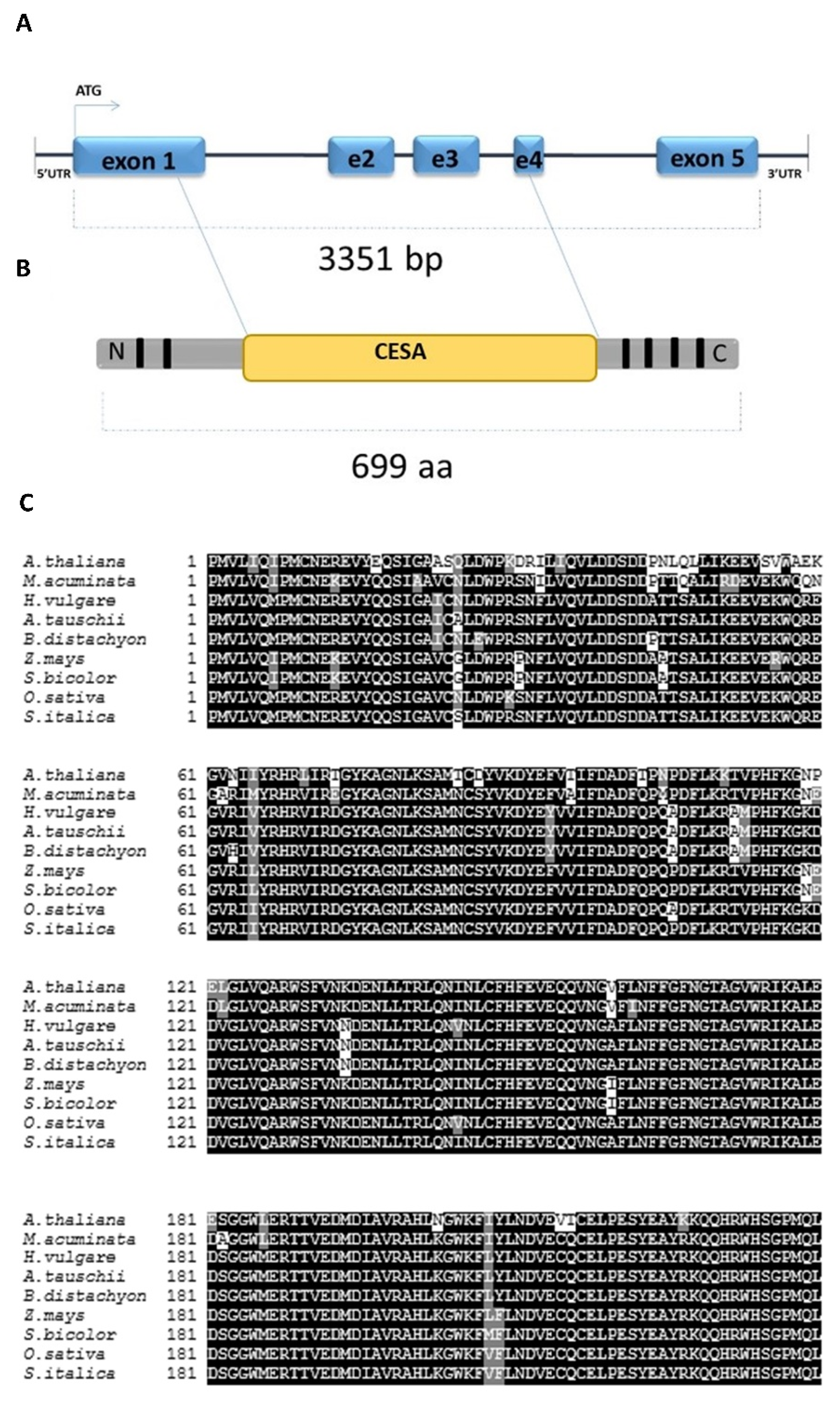

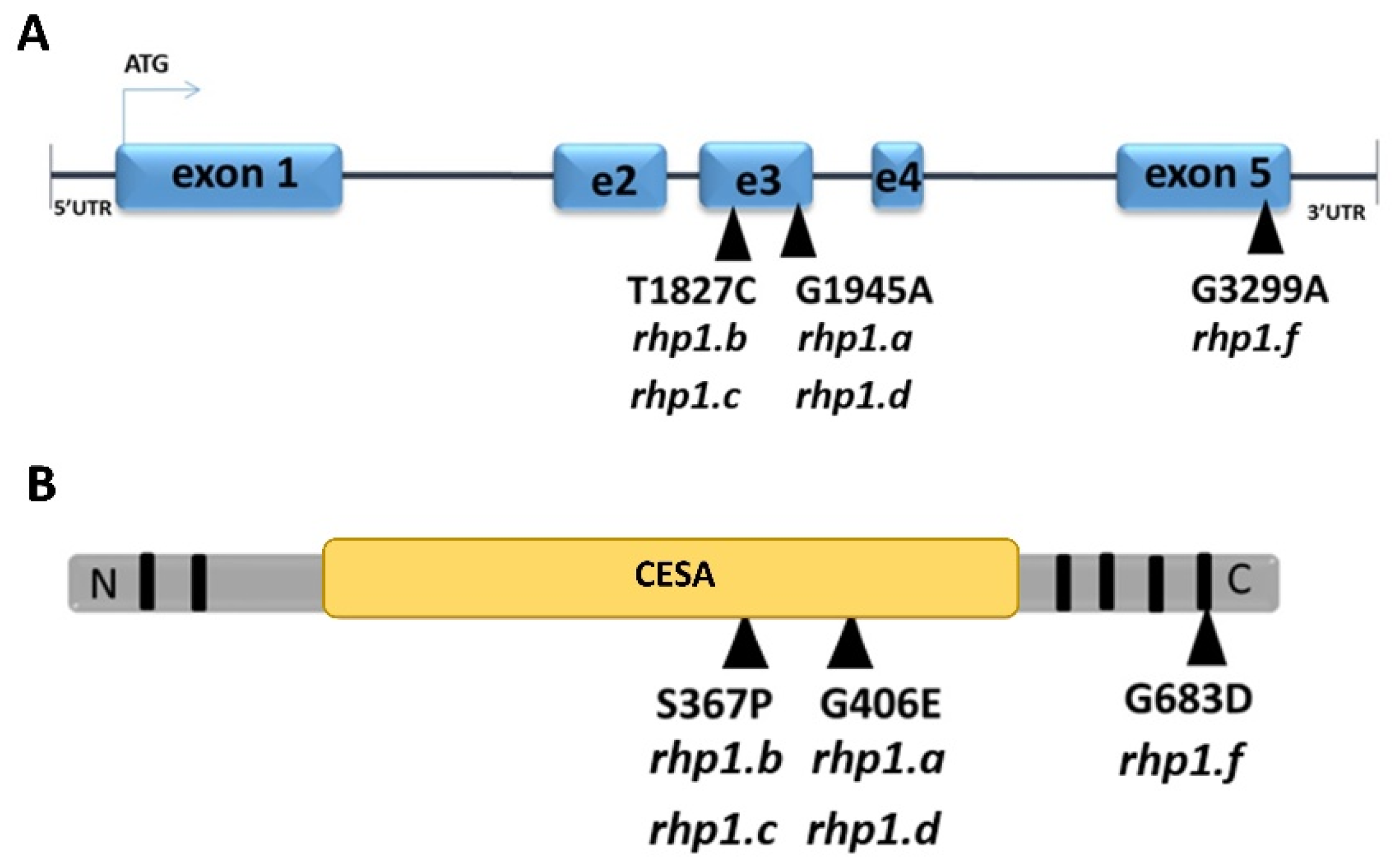
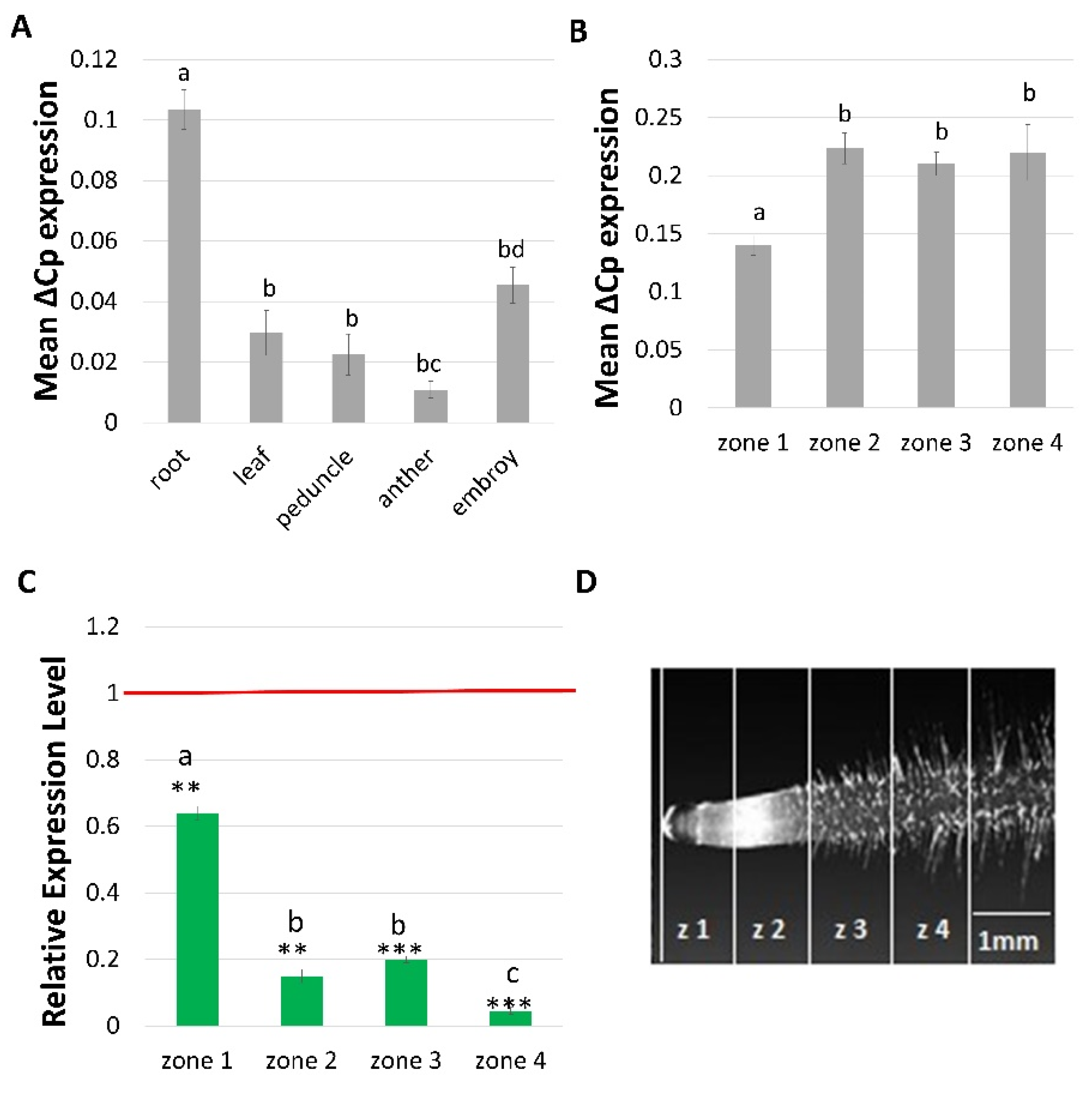

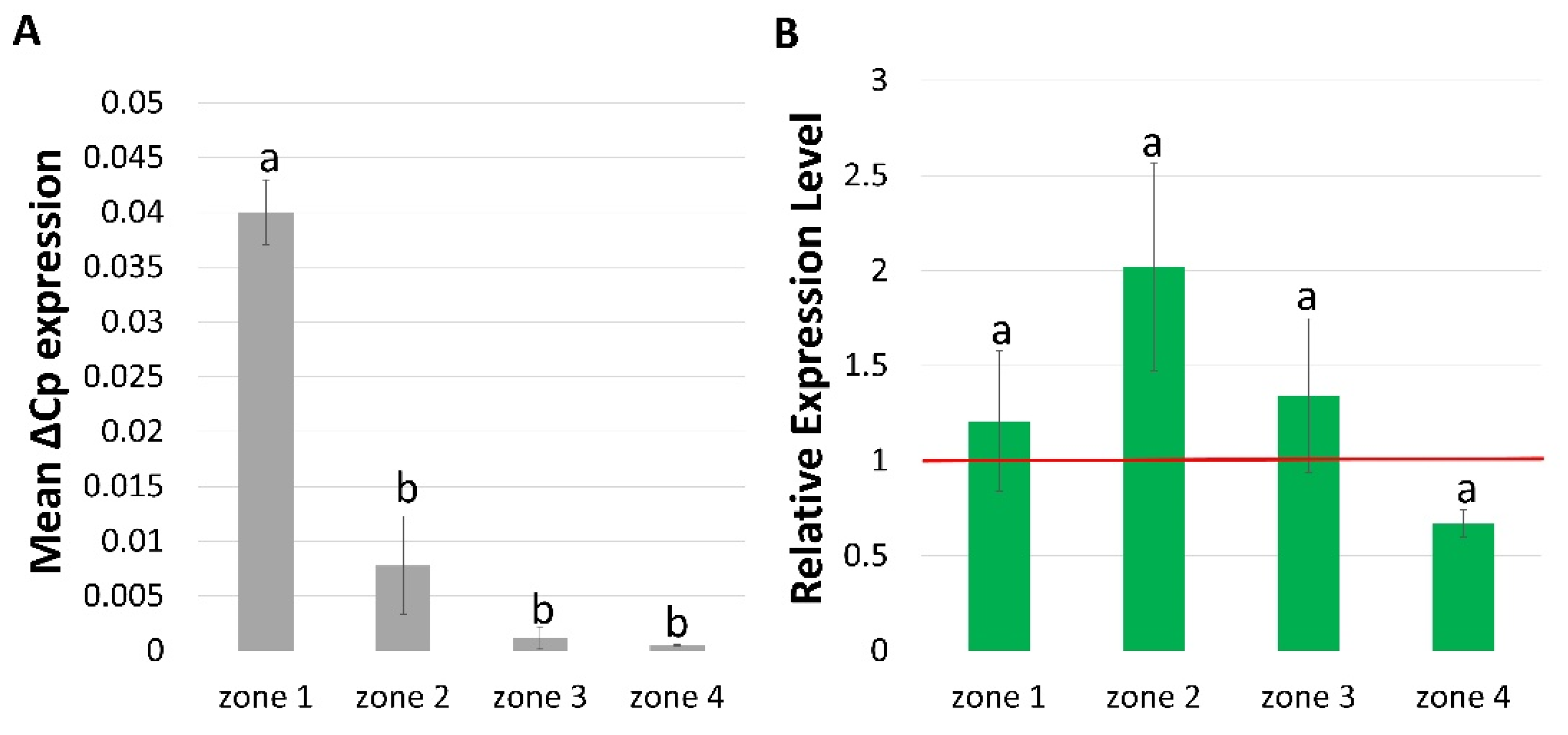
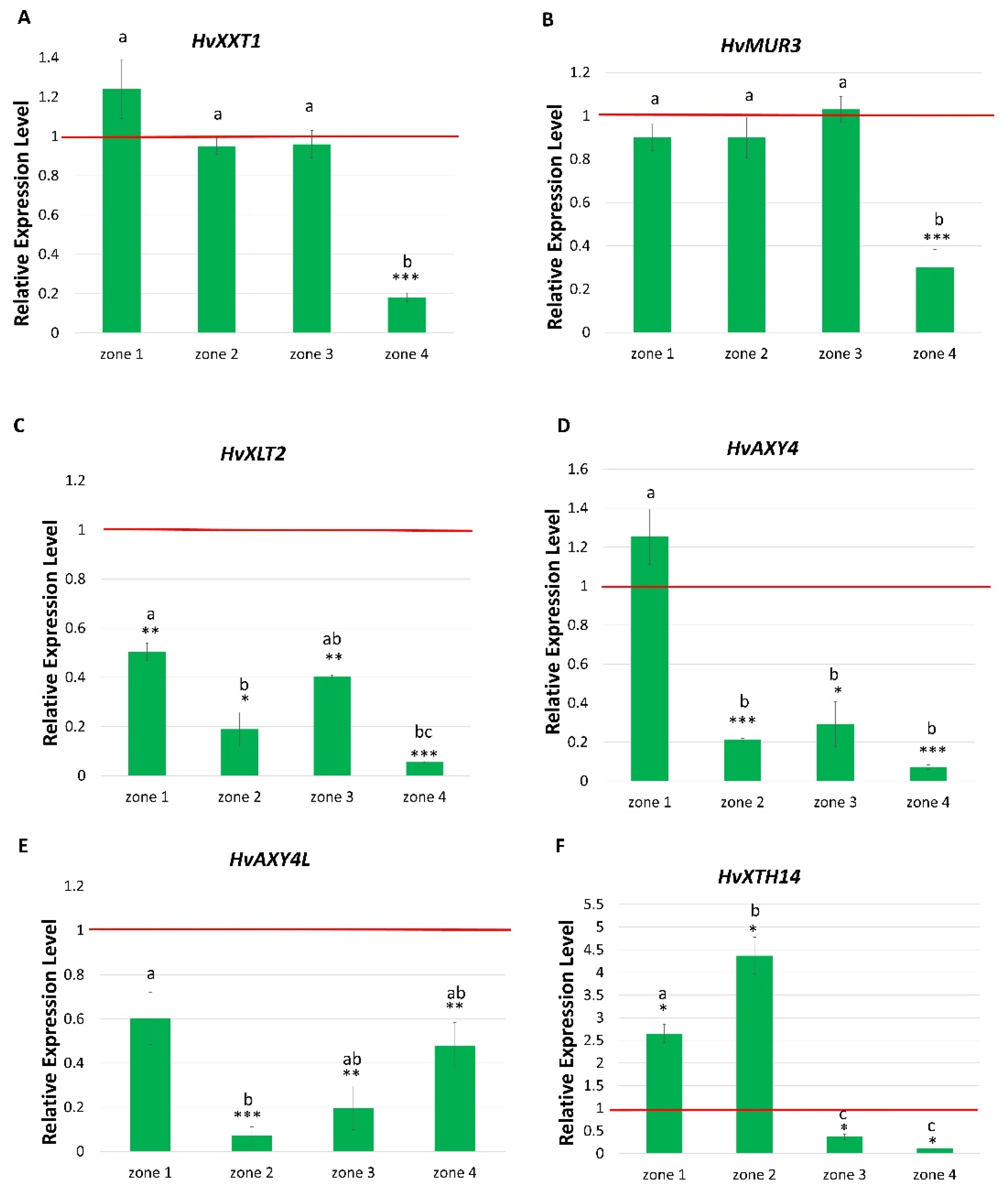

| Mutation Position on Chromosome 1H (bp) | Nucleotide in Reference and WT | Altered Nucleotide | Type of Mutation Identified | Gene ID | Encoded Protein | Ontology | Ortholog ID in A. thaliana or O. sativa | Encoded Protein | Ontology |
|---|---|---|---|---|---|---|---|---|---|
| 18663714 | C | T | Missense | HORVU1Hr1G008530 | RNA polymerase II transcription factor | Regulation of transcription | AT2G42780 | Transcription elongation factor B polypeptide | Transcription elongation from RNA polymerase II promoter |
| 243015321 | G | A | Missense | HORVU1Hr1G036300 | Unknown | Nucleic acid binding | AT3G04610 | RNA-binding KH domain-containing protein/flowering locus KH domain (FLK) | Positive regulation of flower development |
| 400988293 | C | T | Missense | HORVU1Hr1G054230 (MLOC_43237) | Beta expansin protein 5 (HvEXPB5) | Cell wall loosening | AT1G65680 | Beta expansin protein 2 (EXPB2) | Cell wall loosening |
| 443922454 | G | A | Missense | HORVU1Hr1G061210 | Transcription termination factor MTERF4 (mitochondrial transcription termination factors 4) | Plastid rRNA transcription, response to oxidative stress | AT4G02990 | Plastid-localizated protein homologous to mitochondrial transcription termination factors (mTERF) found in animal | Plastid rRNA transcription |
| 445822069 | G | A | Missense | HORVU1Hr1G061630 | Serine protease HTRA1 (high-temperature requirement-A1) | Serine-type endopeptidase activity | No best ortholog found | - | - |
| 455806946 | G | A | Missense | HORVU1Hr1G063510 | Unknown | Oxidoreductase activity | AT4G30720 | FAD/NAD(P)-binding oxidoreductase family protein | Oxidation-reduction process |
| 502083971 | C | T | Missense | HORVU1Hr1G073230 | Coronatine insensitive 1-like protein (COI1) | Regulation of jasmonic acid mediated signaling pathway | AT2G39940 | Coronatine insensitive 1 protein (COI1) | Jasmonic acid mediated signaling pathway |
| 516785752 | G | A | Splice junction | HORVU1Hr1G077230 | Synthase celullose-like protein C1 (HvCSLC1) | Transferase activity, transferring glycosyl groups | Os05g0510800 | Cellulose synthase-like protein C7 (CSLC7) | Cell wall organization |
| Species | Gene | Ensembl/TAIR ID | Encoded Protein | Function (UniProt) | Barley Ortholog | Ensembl ID |
|---|---|---|---|---|---|---|
| Oryza sativa | OsXXT1 | Os03g0300000 | Xyloglucan xylotransferase 1 | Transfers an alpha-D-xylosyl residue from UDP-D-xylose to a glucose residue in xyloglucan, forms an alpha-(1->6)-D-xylosyl-D-glucose linkage | HvXXT1 | HORVU4Hr1G054910 |
| Arabidopsis thaliana | XUT1 (RHS8) | AT1G63450 | Xyloglucan-specific galacturonosyltransferase (root hair specific 8) | Forms the beta-D-galactosyluronic acid-(1->2)-alpha-D-xylosyl linkage, required for root hair development probably by providing important acidic xyloglucans | - | No best ortholog found |
| Arabidopsis thaliana | MUR3 | AT2G20370 | Xyloglucan L-side chain galactosyltransferase position 3 | Involved in the attachment of the Gal residue on the third xylosyl unit within the XXXG core structure of xyloglucan | HvMUR3 | HORVU4Hr1G079030 |
| Arabidopsis thaliana | XLT2 | AT5G62220 | Xyloglucan L-side chain galactosyltransferase position 2 | Forms the beta-D-galactose-(1->2)-alpha-D-xylosyl linkage of xyloglucan | HvXLT2 | HORVU0Hr1G005330 |
| Arabidopsis thaliana | MUR2 | AT2G03220 | Galactoside 2-alpha-L-fucosyltransferase | Galactoside 2-alpha-L-fucosyltransferase activity, Is both necessary and sufficient for the addition of the terminal fucosyl residue on xyloglucan side chains, but is not involved in the fucosylation of other cell wall components | HvMUR2 | HORVU6Hr1G078630 |
| Arabidopsis thaliana | AXY4 (TBL24) | AT1G70230 | Xyloglucan O-acetyltransferase 4 | Transfers of an acetyl group onto O-6 of galactose or glucose residues | HvAXY4 | HORVU7Hr1G039420 |
| Arabidopsis thaliana | AXY4L (TBL22) | AT3G28150 | Xyloglucan O-acetyltransferase 4-like | Transfers of an acetyl group onto O-6 of galactose or glucose residues | HvAXY4L | HORVU7Hr1G039180 |
| Arabidopsis thaliana | XTH14 | AT4G25820 | Xyloglucan endotransglucosylase/hydrolase | Breaks a beta-(1->4) bond in the backbone of a xyloglucan and transfers the xyloglucanyl segment on to O-4 of the non-reducing terminal glucose residue of an acceptor, which can be a xyloglucan or an oligosaccharide of xyloglucan | HvXTH14 | HORVU2Hr1G101240 |
Publisher’s Note: MDPI stays neutral with regard to jurisdictional claims in published maps and institutional affiliations. |
© 2021 by the authors. Licensee MDPI, Basel, Switzerland. This article is an open access article distributed under the terms and conditions of the Creative Commons Attribution (CC BY) license (https://creativecommons.org/licenses/by/4.0/).
Share and Cite
Gajek, K.; Janiak, A.; Korotko, U.; Chmielewska, B.; Marzec, M.; Szarejko, I. Whole Exome Sequencing-Based Identification of a Novel Gene Involved in Root Hair Development in Barley (Hordeum vulgare L.). Int. J. Mol. Sci. 2021, 22, 13411. https://doi.org/10.3390/ijms222413411
Gajek K, Janiak A, Korotko U, Chmielewska B, Marzec M, Szarejko I. Whole Exome Sequencing-Based Identification of a Novel Gene Involved in Root Hair Development in Barley (Hordeum vulgare L.). International Journal of Molecular Sciences. 2021; 22(24):13411. https://doi.org/10.3390/ijms222413411
Chicago/Turabian StyleGajek, Katarzyna, Agnieszka Janiak, Urszula Korotko, Beata Chmielewska, Marek Marzec, and Iwona Szarejko. 2021. "Whole Exome Sequencing-Based Identification of a Novel Gene Involved in Root Hair Development in Barley (Hordeum vulgare L.)" International Journal of Molecular Sciences 22, no. 24: 13411. https://doi.org/10.3390/ijms222413411
APA StyleGajek, K., Janiak, A., Korotko, U., Chmielewska, B., Marzec, M., & Szarejko, I. (2021). Whole Exome Sequencing-Based Identification of a Novel Gene Involved in Root Hair Development in Barley (Hordeum vulgare L.). International Journal of Molecular Sciences, 22(24), 13411. https://doi.org/10.3390/ijms222413411






